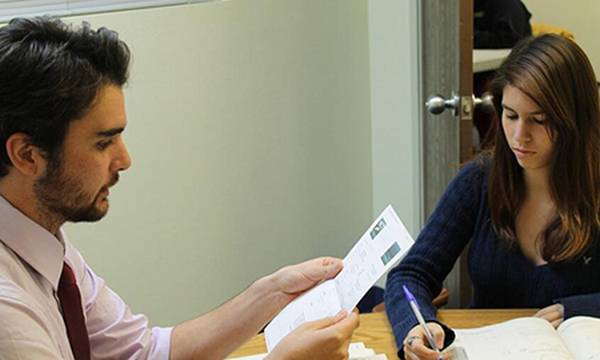一、单项选择题
1.the police are offering a 60000 dollars _____ for information about the killers.
a. priceb. award
c. rewardd. prize
【答案】c。解析:考查词汇辨析。句意:警察对于提供杀人者信息的人悬赏 60000 美元作为回报。a 价格; b 奖励,奖品;c 回报、报酬;d 奖品,难能可贵的事物。故选 c。
2. —look wher you’re going! anything wrong?
—oh, i _____ about the accident i saw in the morning. i was terrified when two cars collided.
a. have thought
c. would think
b. was thinking
d. will be thinking
【答案】b。解析:考查时态。句意:—看你往哪儿走呢?出了什么事?—我在想早晨我看见的那起事故,当两辆车撞上的时候,我害怕极了。根据句意可知后者在叙述刚才自己正在做的事情,所以使用过去进行时,表示在过去的一段时间里作者正在做的事情。
故b 正确。
3.she had just finished her homework _____ her mother asked her to practice playing the piano yesterday.
a. whenb. while
c. afterd. since
【答案】a。解析:考查时间状语从句
。根据主从句的动词时态可知主句谓语动词的动作在从句谓语动词之前已经完成,引导词的意思是:当……的时候,故选 a。
4.could i speak to _____ is in charge of international sales please?
a. whob. what
c. whoeverd. whatever
【答案】c。解析:考查主语从句。whoever 既作 speak to 的宾语,又作 is in charge of international sales 的主语。“whoever”作代词表示“任何人”,“无论谁”。故选 c。
5. —mary, how did your math test go?
—i had thought i _____, but in fact i came in the top 10 in my class.
a. should have failedb. couldn’t have failed
c. might have failedd. shouldn’t have failed
【答案】c。解析:考查虚拟语气。句意:——玛丽,你数学考的怎么样?——我原以为考不过,但却考进了全班前十名。might have failed 可能失败,表推测,预期较弱。结合语境可知,在考试结果没出之前,mary 对自己并没有信心,认为自己可能没考过,故选c。
6.the factory was built in a secret place, around _____ high mountains.
a. which wasb. it was
c. which wered. them were
【答案】c。解析:考查定语从句和倒装。句意:这个工程被建在一个隐秘的地方,在它的周围是高山。which 指代是 the factory,引导非限制性定语从句,around 表示在……周围,构成介词加关系
代词的定语从
句,定语从句中由于地点状语置于句首,全部倒装,故主语为 high mountains 复数形式,谓语动词用复数,故选c。
7.suppose everybody knows that john is an idiot, however, they will laugh at him through another way, for example, john is a big brain.which feature of the theory of conversational implicature does it embody?
a. calculabilityb. cancellability
c. non-detachabilityd. non-conventionality
【答案】c。解析:考查语言学。non-detachability 不可分离性。本题中 big brain 替代了 idiot,同样表达的是头脑愚笨的意思。故选c。
8.which of the following items is a focus of while-reading stage?
a. focusing on pooling students’ existing knowledge about the topic
b. focusing on getting the students familiarized with the culture and social background knowledge relevant to the reading text
c. focusing on process of understanding
d. focusing on producing language based on what they learned
【答案】c。解析:考查阅读教学。a、b 项属于阅读前(pre-reading),d 项属于阅读后(post-reading),只有 c 项属于阅读中(while-reading)。故选 c。
二、简答题
教师如何加强对学生学习策略的指导,为其终身学习奠定基础?
【答案要点】
教师要有意识地加强对学生学习策略的指导,让他们在学习和运用英语的过程中逐步学会如何学习。教师应做到:
(1)积极创造条件,让学生参与制定阶段性学习目标以及实现目标的方法;
(2)引导学生结合语境,采用推测、查阅或询问等方法进行学习;
(3)设计探究式的学习活动,促进学生实践能力和创新思维的发展;
(4)引导学生运用观察、发现、归纳和实践等方法,学习语言知识,感悟语言功能;
(5)引导学生在学习过程中进行自我评价并根据需要调整自己的学习目标和学习策略。
三、教学设计题
请阅读下面学生信息和语言素材,设计 20 分钟的英语阅读教学设计,该方案没有固定的格式,但须包含下列要点:
●teaching objectives
●teaching contents
●key and difficult points
●major steps and time allocation
●activities and justifications
教学时间:20 分钟
学生情况:某城镇普通中学初中一年级(七年级)学生,班级人数 40 人,多数学生已经达到《义务教育英语课程标准(2011 年版)》三级水平。学生课堂积极性一般。
语言素材:
my family
i have a happy family. my family has five people: grandpa, grandma, father, mother, and me. my grandparents live in countryside. they have six rooms. the rooms are big. there are two apple trees in the ground. they have sixteen goats and three cows. the goats are white. the cows are yellow. they are healthy.
【参考设计】
teaching contents: a paragraph about “my family”.
teaching objectives:
(1) knowledge objective:
students should master the new words and phrases.
(2) ability objective:
students can improve the four skills of english, especially reading ability.
(3) emotional objective:
students can love not only their family members but also people around them.
teaching key points:
master the pronunciations of the new words and the phrases and the usage of the sentence patterns.
teaching difficult points:
how to put the new knowledge into practice and use it to communicate with others correctly and fluently?
teaching procedures:
step 1: pre-reading (5 minutes)
show the students some pictures, in which are the teacher’s family members. let students guess the people in the pictures and think about their own family members. then ask some volunteers to share their opinions about their families with the whole classes.
(justification: pictures can arouse students’ interest. the activity can get students involved in the topic of the lesson.)
step 2: while-reading (10 minutes)
at this step the teacher will ask the students to do two activities. activity 1: fast reading
students will be given one minute to read the short passage quickly, and then conclude the main idea.
activity 2: careful reading
the teacher will give them 5 minutes to read it again. then let them do a task:
the teacher will ask the students to underline the difficult words or phrases. in order to practice their ability to think, the teacher will encourage them to analyze the text by themselves first and then to discuss with their group members. at last the teacher will explain them some examples and exercises to help them understand.
(justification: different ways of exploiting the text can help students not merely to cope with one particular text in class but to develop their reading strategies and reading ability.)
step 3: post-reading (5 minutes)
the teacher asks the students to discuss the most interesting story happened in their families in group. after the discussion the teacher asks them to recommend the most interesting story in each group, and let one student share the story with the whole class.
(justification: help the students have a better understanding of the topic of family.)